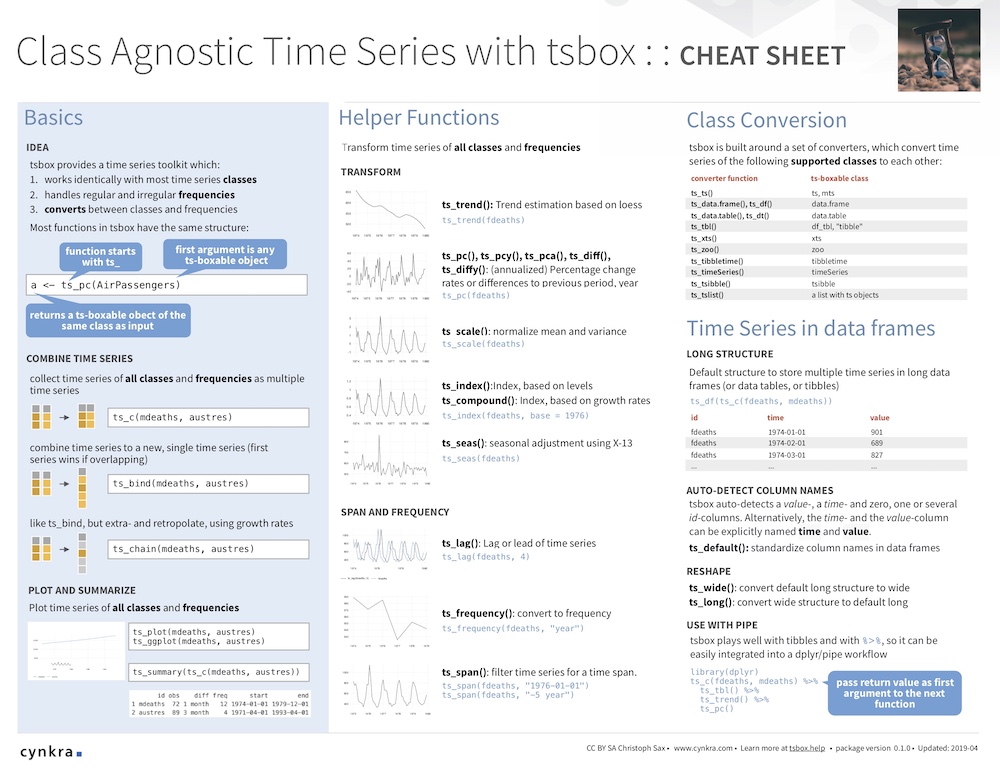The R ecosystem knows a vast number of time series classes: ts, xts, zoo, tsibble, tibbletime or timeSeries. The plethora of standards causes confusion. As different packages rely on different classes, it is hard to use them in the same analysis. tsbox provides a set of tools that make it easy to switch between these classes. It also allows the user to treat time series as plain data frames, facilitating the use with tools that assume rectangular data.
 comic by xkcd
comic by xkcd
The tsbox package is built around a set of functions that convert time series of different classes to each other. They are frequency-agnostic and allow the user to combine multiple non-standard and irregular frequencies. Because coercion works reliably, it is easy to write functions that work identically for all classes. So whether we want to smooth, scale, differentiate, chain-link, forecast, regularize, or seasonally adjust a time series, we can use the same tsbox-command for any time series class.
This blog gives a short overview of the changes introduced in 0.1. A detailed overview of the package functionality is given in the documentation page (or in a previous blog-post).
Keeping explicit missing values
Version 0.1, now on CRAN,
brings many bug fixes and improvements. A substantial change involves
the treatment of NA values in data frames. Previously, all NAs in
data frames were treated as implicit and were only made explicit by a
call to ts_regular.
This has changed now. If you convert a ts object to a data frame, all
NA values will be preserved. To replicate previous behavior, apply the
ts_na_omit function:
library(tsbox)
x.ts <- ts_c(mdeaths, austres)
x.ts
ts_df(x.ts)
ts_na_omit(ts_df(x.ts))
ts_span extends outside of series span
This lays the groundwork for
ts_span to be
extensible. With extend = TRUE, ts_span extends a regular series
with NA values, up to the specified limits, similar to base window.
Like all functions in tsbox, this is frequency-agnostic. For example, in
the following, the monthly series mdeaths is extended by monthly NA
values, while the quarterly series austres is extended by quarterly
NA values.
x.df <- ts_df(ts_c(mdeaths, austres))
ts_span(x.df, end = "1999-12-01", extend = TRUE)
ts_default standardizes column names in a data frame
In rectangular data structures, i.e., in a data.frame, a data.table,
or a tibble, tsbox stores one or multiple time series in the ‘long’
format. By default, tsbox detects a value, a time and zero, one or
several id columns. Alternatively, the time column and the value
column can be explicitly named time and value. If explicit names are
used, the column order will be ignored.
While automatic column name detection is useful in interactive mode, it
produces unnecessary overhead in longer workflows. The helper function
ts_default detects
and renames the time and the value column so that auto-detection will be
turned off in subsequent steps (note that the names of the id columns
are not affected):
x.df <- ts_df(ts_c(mdeaths, austres))
names(x.df) <- c("a fancy id name", "date", "count")
ts_plot(x.df) # tsbox is fine with that
ts_default(x.df)
ts_summary summarizes time series
ts_summary
provides a frequency agnostic summary of a ts-boxable object:
ts_summary(ts_c(mdeaths, austres))
#> id obs diff freq start end
#> 1 mdeaths 72 1 month 12 1974-01-01 1979-12-01
#> 2 austres 89 3 month 4 1971-04-01 1993-04-01
ts_summary returns a plain data frame that can be used for any
purpose. It is also recommended for the extraction of various time
series properties, such as start, freq or id:
ts_summary(austres)$id
#> [1] "austres"
ts_summary(austres)$start
#> [1] "1971-04-01"
And a cheat sheet!
Finally, we fabricated a tsbox cheat sheet that summarizes most functionality. Print and enjoy working with time series.



